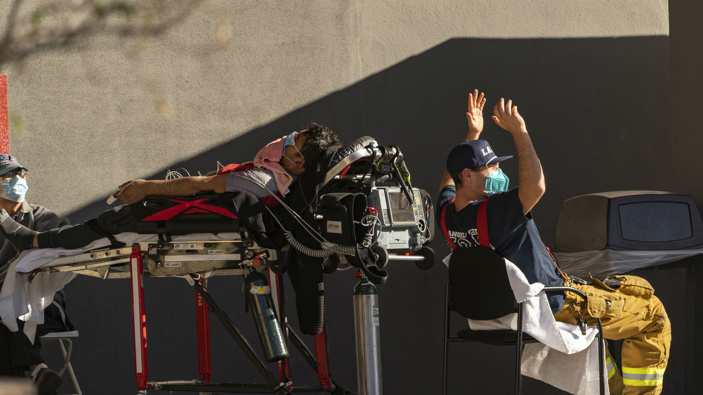Just over a year since the first known US Covid-19 death, more than 500,000 people will have died from the disease by the end of this week.
"It's something that is historic. It's nothing like we've ever been though in the last 102 years since the 1918 influenza pandemic," said Dr. Anthony Fauci, director of the National Institute of Allergy and Infectious Diseases.
"It really is a terrible situation that we've been through and that we're still going through. And that's the reason why we keep insisting to continue with the public health measures -- because we don't want this to get much worse than it already is."
More than 497,600 people have died from Covid-19 in the US, according to Johns Hopkins University.
And another 91,000 Americans are projected to die from the disease by June 1, according to the University of Washington's Institute for Health Metrics and Evaluation.
Decreases in new Covid-19 cases and hospitalisations in recent weeks have prompted some state and local leaders to loosen restrictions.
But as new coronavirus variants spread, health experts say it's critical to double down on safety measures to prevent yet another catastrophic surge.
"The most uncertain driver of the trajectory of the epidemic over the next four months is how individuals will respond to steady declines in daily cases and deaths," the IHME team wrote.
"More rapid increases in mobility or reductions in mask use can easily lead to increasing cases and deaths in many states in April."
'Rapid growth' of the B.1.1.7 strain expected
Several new concerning variants of coronavirus have been found in the US, including the highly contagious B.1.1.7 strain first detected in the UK.
The IHME team said the B.1.1.7 strain likely accounts for less than 20% of coronavirus infections now, but could jump to 80% by late April.
And the Centers for Disease Control and Prevention has projected a "rapid growth" of the B.1.1.7 strain across the US, saying it will likely become the predominant variant in the country by March.
The good news: Americans can fend off the B.1.1.7 strain (and other variants) by wearing masks, keeping their distance from others, and getting vaccinated once they're able to.
Lab studies suggest vaccines can protect against coronavirus variants. And health experts say vaccinations help prevent the virus from mutating further.
Rapid, widespread vaccinations are important to stay ahead of "the inevitable evolution of variants that could dangerously accelerate the trajectory of the pandemic," CDC Director Dr. Rochelle Walensky co-wrote in the medical journal JAMA.
The troubling B.1.351 strain has spread to New York
Another disturbing variant, the B.1.351 strain first found in South Africa, has now been detected in a Nassau County resident, New York Gov. Andrew Cuomo said Sunday.
The CDC says at least 10 states have reported cases of the B.1.351 strain, which has worried scientists because it has a mutation that might affect the efficacy of current vaccines.
In lab studies testing the Pfizer/BioNTech and Moderna vaccines, researchers did find reduced antibody responses to viruses genetically engineered to look like the B.1.351 variant. Despite those reductions, experts say they believe the vaccines still likely offer good protection against this strain.
"We don't believe the South African variant is more deadly, but it may be more contagious," Nassau County Executive Laura Curran said after the B.1.351 strain was found from a New York resident.
And "with the discovery of a case of the South African variant in the state, it's more important than ever for New Yorkers to stay vigilant, wear masks, wash hands and stay socially distanced," Gov. Cuomo said.
"We are in a race right now -- between our ability to vaccinate and these variants which are actively trying to proliferate. And we will only win that race if we stay smart and disciplined."
5.7% of US is fully vaccinated
It will be months before the US reaches any kind of herd immunity -- and that's only if enough people are willing to get vaccinated so life can return to normal.
So far, more than 43.6 million people have received at least the first dose of a Covid-19 vaccine, according to CDC data.
More than 18.8 million Americans have been fully vaccinated with a second dose. That's about 5.7% of the US population.
Herd immunity is reached when the majority of the population becomes immune to an infectious disease -- either through infection and recovery or through vaccination.
Fauci estimates between 70% to 85% of the US population needs to be immune for herd immunity to take effect against the virus.
The IHME team wrote they do not expect the country will reach herd immunity before next winter.
"The model suggests that we should have a quiet summer," IHME Director Dr. Chris Murray said.
"But we know Covid's really seasonal, so when the next winter rolls around, we need to have a much higher level of protection to stop Covid in its tracks than we're likely to achieve."
To speed up getting at least the first doses into arms, the US should consider delaying the second dose of vaccines, another expert said.
"Everybody needs a second dose, there's no question about that," Dr. Ashish Jha, dean of the Brown University School of Public Health, said Friday. "I think the question is, right now we wait four weeks between first and second dose. What if we went six weeks or eight weeks or 10 weeks -- not much longer than that."
His comments came the same day two top US officials -- Andy Slavitt, senior adviser to the White House Covid-19 response team and Fauci -- said they don't think the US should delay or skip second vaccine doses. Jha says his suggestion is middle ground to vaccinate more high-risk people quickly.
Teachers' union: CDC guidelines a 'safety guard rail'
School reopening guidelines released by the CDC this month focus on five key Covid-19 mitigation strategies: the universal and correct wearing of masks; physical distancing; washing hands; cleaning facilities and improving ventilation; and contact tracing, isolation and quarantine.
Vaccine and testing are "additional layers" of protection, the agency said.
The CDC director told a White House briefing Friday that with those strategies, schools may open no matter how much virus is spreading within a community.
"There are opportunities for in-person learning at all stages of ... community spread," Walensky said. "I would actually invite schools to lean in and to look at what is needed ... to try and get more and more children back to school."
Randi Weingarten, the president of the American Federation of Teachers, told CNN Saturday the agency's guidelines are a "safety guard rail" for teachers -- and in a recent poll, most educators said they'd be comfortable returning to class with the help of testing, vaccine prioritization and mitigation strategies in place.
But so far, only about 28 states and Washington, DC, have started allowing all or some teachers and school staff to receive the vaccine.
And schools face another challenge when it comes to reopening for in-person instruction, Weingarten added.
When schools do put some of those measures in place, including smaller class sizes and social distancing, they need more space and more educators, Weingarten, said.
"The reason that you have so many places that are in hybrid is because they don't have the space and they don't have the educators," she said. "The real issue right now is how do we help take the places that are on remote and turn it around."
text by Christina Maxouris and Holly Yan, CNN
Take your Radio, Podcasts and Music with you










